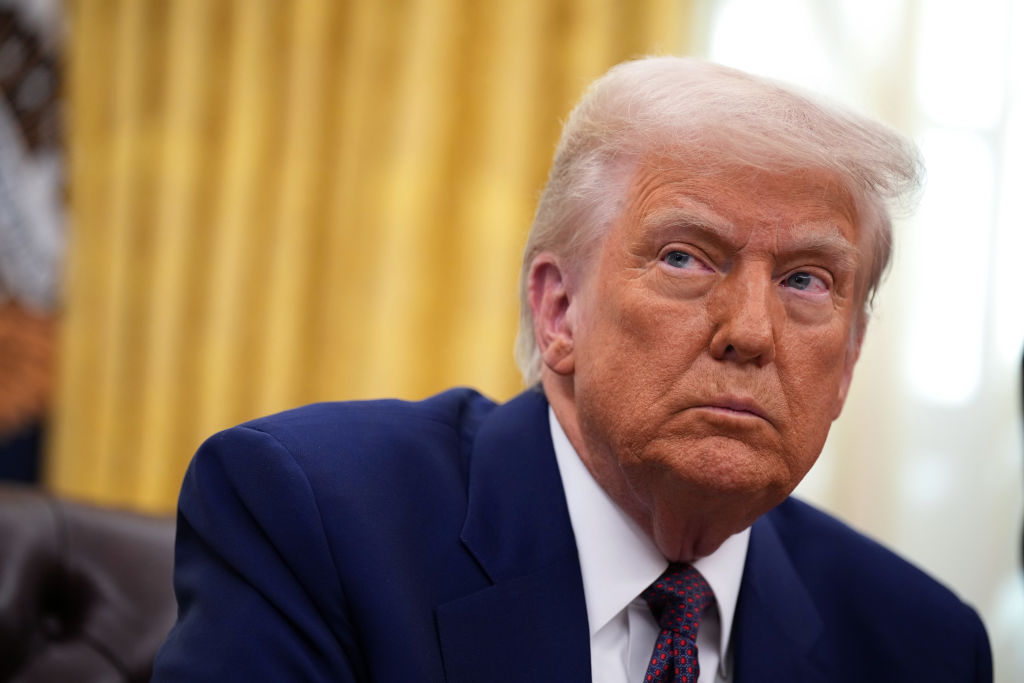There’s something about Donald Trump that sends Europeans mad. The President and Vladimir Putin agreed last week to commence talks about ending Russia’s war in Ukraine. From the hysterical reaction, you would have thought Trump had handed Putin the keys to Kyiv.
Shrill cries of surrender, betrayal and appeasement are premature; extremely difficult negotiations lie ahead, involving Ukraine, on the precise terms of any deal. And Putin himself has blinked by abandoning many of his pre-conditions for talks set out last year.
The mood among European security panjandrums at this weekend’s Munich Security Conference was fraught. European leaders claim to have been blindsided by Trump’s move, and shocked by the US defence secretary’s statement that ‘stark strategic realities prevent the United States of America from being primarily focused on the security of Europe’.
These claims are nonsense; Trump’s second-term plans to cut a deal with Putin over Ukraine and for the US to take a back seat in Europe emerged a year ago, not last week, and have been briefed to capitals since last November’s election. Europe didn’t listen or didn’t want to, or thought Trump would resile from his campaign rhetoric.
Europe is now panicking because it has grown accustomed to the US security comfort blanket, underinvested in defence for years, not heeded what Trump has been saying, nor prepared adequately for his second presidency. The consequences of this strategic misjudgement are now becoming clear.
On Nato, as part of its ongoing pivot to Asia, Trump’s advisers made clear that in his second presidency the US would step back from being the primary conventional security provider in Europe while remaining the ultimate nuclear guarantor. They assess that a much-weakened Russia is unable or willing to attack Nato. European manpower should be the primary bulwark of Europe’s frontiers which will end local free-loading and allow US forces to deter China.
Moreover, as part of a ‘Dormant Nato’, they see no further territorial enlargement of the alliance eastwards, which has long encouraged western Europe – including the UK – to disarm, and to become dependent on the US in eastern Europe.
On Ukraine, Trump doesn’t regard a ‘war in the far eastern reaches of Europe’ as being a core US strategic interest. The President, in the words of Defence Secretary Pete Hegseth, wants to hand the problem to Europe, with it ‘taking overwhelming share of future lethal and nonlethal aid to Ukraine’. European soldiers should keep the peace between Ukraine and Russia, and there will be reduced US assistance in the region. There are other demands too: no Ukrainian membership in Nato for the foreseeable future (which in any case is opposed by other European countries); no US combat troops in Ukraine (a US red line since the 1990s); Ukrainian elections; and a monitored ceasefire in place along the current front line. Other steps on reconstruction and restitution will then follow.
Although decried by some as giving unilateral concessions to Russia, Trump’s emerging strategy could still, as a former US Ambassador said, be the basis for a successful if unpalatable outcome. This all assumes that Putin actually wants peace, or can be coerced into it.
Trump’s plans have gone down like a cup of cold sick
It was these approaches – on Nato and Ukraine – that Pete Hegseth unambiguously set out in Brussels. They are linked by a shared demand that ‘safeguarding European security must be an imperative for European members of Nato.’
Trump’s plans have gone down like a cup of cold sick. Although Europe may, as one senior Trump adviser put it, have already gone through the various stages of grief with Trump from denial, through anger, bargaining and now depression, it still finds itself again having to react, confronted by the results of its previous sloth. Waiting for Trump’s term to end in the hope for a change in direction is also unwise; US shift in focus on China is ‘generational and bi-partisan’.
Shaking off 30 years of cosy post-Cold War assumptions, steady disarmament, and increasing dependency on the US isn’t going to be an easy or popular task. European leaders haven’t explained the very real possibility of US disengagement with their publics, nor set out the likely need for defence spending to increase to rebuild defence capacity, plug US gaps or fill a new, enduring commitment to Ukraine.
Being mad at Trump and accusing him of perfidy may make us feel better but it won’t ensure European security or help Ukraine. President Macron is for once right: describing Trump’s return as an ‘electroshock’, Europe needs to ‘muscle up’ its defences.
The UK is no exception. Our armed forces are in a terrible state. Fraser Nelson wrote that, on defence, ‘Britain has come to specialise in rousing, unfunded words; heroic, undeliverable promises’. This government is no different, with Starmer’s emissaries to Munich still, despite US statements, trotting out its tired mantra about ‘setting out the path’ to spending 2.5 per cent of GDP on defence when ‘economic circumstances’ allow.
Any ploy to kick any increase in defence spending into the long grass is clearly obsolete. Starmer said in Kyiv in January that ‘peace through strength must be more than words, it’s got to be actions’. Trump has called his bluff.







Comments